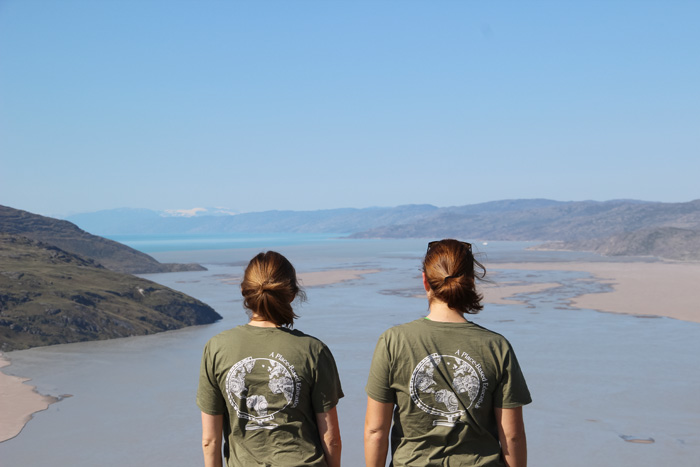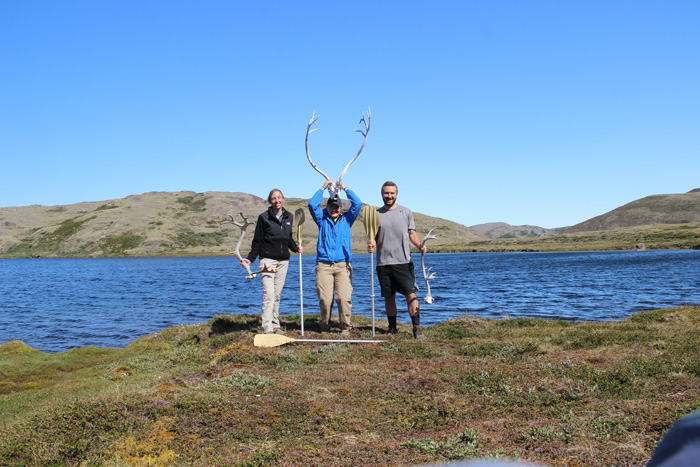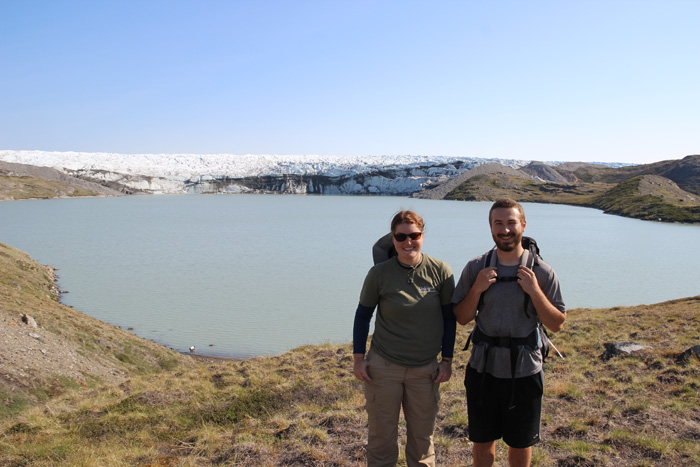20,000 Lakes

Helen Schlimm '17 and Assistant Professor of Environmental Studies Kristin Strock take a long look over one of Greenland's many lakes.
Student-faculty research expedition explores climate change in Greenland
by Tony Moore
Sometimes an “out of the classroom experience” is a little hard to put into words. And probably because it was just so amazing.
“There’s no way to prepare yourself to get off that plane and see giant dusty hills, tundra, wildflowers, lichen—it’s just really unbelievable and really hard to explain, too, when you get back. It’s like, ‘How was Greenland?’ ‘Well ... really fantastic!’ ”
This is Helen Schlimm ’17 (environmental science), and she was in Greenland over the summer of 2015 to study how some of the region's 20,000 lakes might reflect patterns in climate change. Schlimm made basecamp in Kangerlussuaq with Assistant Professor of Environmental Science Kristin Strock, Max Egener ’16 (environmental science) and Jasmine Saros, professor of paleolimnology and lake ecology at the University of Maine.

Strock, Schlimm and Egener enjoying all the tundra Greenland has to offer.
Strock has been collaborating on a related project with Saros’ University of Maine team, and she says the research Schlimm has been developing from the Greenland trip is a continuation of that work and will be added as another spoke to the larger project.
“A lot of the research in this area of Greenland is focused on algae, the base of the food web,” Strock explains. “And there have been dynamic shifts with climate and the effects of climate [on algae]. So Helen’s project is the next step, looking at the next level in the food web.”

Schlimm and Egener dress for summer weather as ice and snow lurk in the background.
Schlimm’s research—which she returned to this summer after a year abroad in Germany—focuses on how that next level in the food web might be affected by those “dynamic shifts.” Specifically, how zooplankton—various and often microscopic aquatic organisms that eat algae—are changing.
“Our samples are showing that there’s a change in the dominance of various communities of zooplankton,” Schlimm explains, noting that the project has become her senior research project. “That dominance can be attributed to changing physical conditions, chemical conditions, how much algae is available to them or climate conditions. So that’s what we’re starting to look at.”
“We have an idea of how climate is altering these systems, and we have to find out whether our thinking is correct in that, to test that,” says Strock. “Once Helen finishes her work, we’ll have an idea of how the upper trophic levels might be responding.”
The trip was made possible, as are many Dickinson research excursions, by the support of alumni, in this case Betty Churchill ’58 and her husband, Dan, who went to the University of Maine. “By joining with UMaine, we were able to pursue exciting research questions in a remote and difficult location," Strock says. "All of which was made possible with the support of Betty and Dan.”
Continuing with her work outside the classroom, Schlimm will leave the tundra of Greenland behind in exchange for the temperate climes of Hawaii, when she travels there in February with Strock to present her work at an international conference.
“We’ve got some really interesting initial results, so we’ll see how else the story sort of unfolds,” says Schlimm. “And it all started in Greenland.”
Learn more
- Department of Environmental Studies & Environmental Science
- Research at Dickinson
- "Gates of the Arctic, Up Close and Personal"
- "When It Rains"
- Alliance for Aquatic Resource Monitoring
- Latest News
Published November 11, 2016